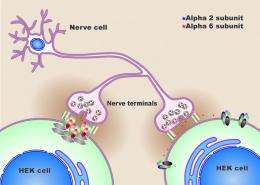New model synapse could shed light on disorders such as epilepsy and anxiety

(Phys.org) -- A new way to study the role of a critical neurotransmitter in disorders such as epilepsy, anxiety, insomnia, depression, schizophrenia, and alcohol addiction has been developed by a group of scientists led by Gong Chen, an associate professor of biology at Penn State University. The new method involves molecularly engineering a model synapse -- a structure through which a nerve cell send signals to another cell. This model synapse can precisely control a variety of receptors for the neurotransmitter called GABA, which is important in brain chemistry. The research, which will be published in the Journal of Biological Chemistry on 10 August 2012, opens the door to the possibility of creating safer and more-efficient drugs that target GABA receptors and that cause fewer side effects.
Neurotransmitters -- chemicals sent by nerves to trigger other cells to change their electrical responses -- interact with special receptors located on the cell's outer membrane. These receptors form inside the cell, and then are transported to different locations on the membrane to await the arrival of neurotransmitters. Chen explained that understanding how these receptors work and how they move to various locations on a cell's membrane is a critical step toward the development of new drugs targeting diseases that affect brain chemistry.
In their study, Chen and his team focused on a particular receptor -- called the GABA-A receptor-- that responds to the neurotransmitter GABA. "The GABA-A receptors are associated with various disorders in which nerve-cell excitability is altered, such as epilepsy and anxiety, and these receptors mediate major inhibition in the brain," Chen explained. "Each GABA-A receptor protein is made up of five subunits and there are 19 possible subunits that can combine in various ways to form any single receptor. We focused on a particular group of subunits called Alpha, and how changing these tiny subunits might affect the GABA-A receptor's location on the cell membrane."
First, Chen and his team used molecular engineering techniques to develop a model synapse between a nerve cell and a special kind of kidney cell used widely in cell-biology research -- called an HEK cell -- in order to study how specific receptors behaved. They then altered the Alpha subunits in the GABA-A receptors expressed in the kidney cell in order to test how a single variation might affect the behavior of the receptor. They found that the receptors behaved very differently in response to the GABA neurotransmitter, depending on whether they had an Alpha 2 or an Alpha 6 subunit. "Not only do the Alpha subunits play an important role in determining how the GABA-A receptor responds to the neurotransmitter, but the Alpha 2 and Alpha 6 subunits also guide the receptors to very different regions on the cell membrane," Chen said.
Specifically, Chen and his collaborators found that when a GABA-A receptor had an Alpha 2 subunit, the receptor tended to cluster at the synaptic region on the cell membrane. However, when a GABA-A receptor had an Alpha 6 subunit, the receptor tended to migrate to a different area on the cell membrane called the extrasynaptic region.
Chen explained that understanding such a difference in receptor behavior can be especially important in predicting what side effects a drug might cause. For example, many GABA-receptor-targeting drugs such as Valium and Xanax, which are used to treat anxiety, appear to directly change the GABA neurotransmitter's synaptic transmission, significantly altering nerve-cell activity and causing side effects such as confusion, agitation, and memory loss.
"If we imagine that a cell represents a big city, then the synaptic regions are major highways leading to the city," Chen said. "There are serious side effects of disrupting those 'major highways' because brain function relies upon a delicate excitation-inhibition balance and breaking that balance will affect the output of neural circuits." Chen added that, in the same analogy, the extrasynaptic regions could be thought of as the less-trafficked, but numerous smaller roads. "The idea is that if drugs could be developed that manipulate only the extrasynaptic receptors rather than the synaptic receptors, the 'major highways' would remain undisturbed and the heavy traffic could continue with less interruption. That is, targeting extrasynaptic receptors by modulating the Alpha 6 subunit represents a step toward creating new drugs with fewer side effects."
Journal information: Journal of Biological Chemistry
Provided by Pennsylvania State University

















